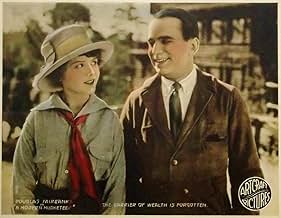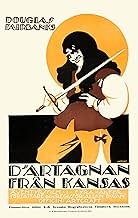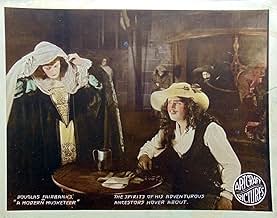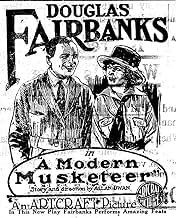अपनी भाषा में प्लॉट जोड़ेंA restless young man travels west, encountering adventure, romance, and danger.A restless young man travels west, encountering adventure, romance, and danger.A restless young man travels west, encountering adventure, romance, and danger.
फ़ीचर्ड समीक्षाएं
DOUGLAS FAIRBANKS was quite the swashbuckler of his era in the 1920s, especially during the time of his biggest triumphs in ROBIN HOOD, THE THIEF OF BAGDAD, THE MARK OF ZORRO and THE BLACK PIRATE.
But this is an early relic from his silent screen career as early as 1917, and, of course, has to be judged by today's standards of film-making for any potential viewers outside of curious film buffs who want to see it.
Fairbanks was athletic and agile enough, but always looked middle-aged, even though here he's only 34. Furthermore, he looked husky rather than trim--unlike his son, Douglas Fairbanks, Jr., a much better looking man. But his physical prowess is amazing. He clambers over fences, cars, horses in a mere jump. He climbs up over anything in his way with the ease of a monkey swinging through trees, exuberantly smiling while he struts his way through whatever impediment is in his way.
And the film itself, for a relic that was filmed in 1917, is in amazingly good condition, fully restored and with a jaunty background score that is not jarring and obtrusive the way so many of the silent film scores were.
The story is really two stories that run concurrently: the D'Artagnan legend is illustrated in a few brief scenes of derring-do with Fairbanks rescuing a damsel in distress. The young Kansas man who desperately wants to leave his provincial roots (in a scene deliriously overplayed by Fairbanks) is also anxious to have a life of adventure and romance, like D'Artagnan. His father and mother give him their blessing and send him on his way--and the rest of the plot is predictable but fun to watch as he finds his own damsel in distress to rescue from a villainous man.
Fun, and thin on plot--but it does move as briskly as Fairbanks himself. Amusing to realize that only twenty years later, his son, Douglas Fairbanks, Jr. would be in a little swashbuckler called THE PRISONER OF ZENDA.
But this is an early relic from his silent screen career as early as 1917, and, of course, has to be judged by today's standards of film-making for any potential viewers outside of curious film buffs who want to see it.
Fairbanks was athletic and agile enough, but always looked middle-aged, even though here he's only 34. Furthermore, he looked husky rather than trim--unlike his son, Douglas Fairbanks, Jr., a much better looking man. But his physical prowess is amazing. He clambers over fences, cars, horses in a mere jump. He climbs up over anything in his way with the ease of a monkey swinging through trees, exuberantly smiling while he struts his way through whatever impediment is in his way.
And the film itself, for a relic that was filmed in 1917, is in amazingly good condition, fully restored and with a jaunty background score that is not jarring and obtrusive the way so many of the silent film scores were.
The story is really two stories that run concurrently: the D'Artagnan legend is illustrated in a few brief scenes of derring-do with Fairbanks rescuing a damsel in distress. The young Kansas man who desperately wants to leave his provincial roots (in a scene deliriously overplayed by Fairbanks) is also anxious to have a life of adventure and romance, like D'Artagnan. His father and mother give him their blessing and send him on his way--and the rest of the plot is predictable but fun to watch as he finds his own damsel in distress to rescue from a villainous man.
Fun, and thin on plot--but it does move as briskly as Fairbanks himself. Amusing to realize that only twenty years later, his son, Douglas Fairbanks, Jr. would be in a little swashbuckler called THE PRISONER OF ZENDA.
This Douglas Fairbanks vehicle has been noted for its scenes of Fairbanks dressed as D'Artagnan ("The Three Musketeers") anticipating the star's later redirection of his career in the 1920s to more prestigious, costume/historical swashbucklers. Otherwise, "A Modern Musketeer" is similar to the usual modern comedies Fairbanks made before "The Mark of Zorro" and "The Three Musketeers" transformed his career. His scenes as D'Artagnan are only a small part of the picture-mostly the opening sequence where Doug swordfights every man in a tavern to humorously retrieve a lady's handkerchief. Framing this sequence, Fairbanks literally winks at the camera, which the Flicker Alley commentary suggests was to reassure audiences that they were watching the same old Doug, who had by this time firmly established a popular comedic screen persona.
I like Fairbanks's comedies and have viewed about every complete one I could find on home video, but, admittedly, even the best formulas eventually get tiresome and in need of some revision and innovation. The first part of "A Modern Musketeer" is, thus, interestingly unusual. Besides the opening swashbuckling, other sequences seem to be in non-chronological order: first, there's a mythological past of D'Artagnan with a modern sense of humor, then a near-contemporary scene where modern Doug destroys another, but modern, tavern, as he again knocks men about to defend a woman's honor, followed by the cyclone scene of Doug's character's birth and, then, another near-present scene on a streetcar involving giving up seats for ladies. After this, we mostly follow the main chronological story as our hero leaves home and eventually saves the day at the Grand Canyon.
As in his other comedies, Fairbanks is established as out-of-place in modern society, for his restless exuberance and chivalry at the expense of clobbering any fellow seeming to be in his way. The film suggests that this kind of man was more at home in the past, such as in the case of D'Artagnan. The setting of historical swashbucklers befitted Fairbanks's persona, whereas the modern comedies found their comedy in Fairbanks's awkwardness in modern times and his transformation within those constraints. He doesn't belong in his small hometown in Kansas, so he leaves for adventure.
Overall, this is a good Fairbanks comedy. It's the earliest one I've seen directed by Allan Dwan, who was taking over for John Emerson as the star's main director. Apparently, scenarist and title writer Anita Loos had also already departed from Fairbanks's team of filmmakers, but her influence continued to be seen in witty title cards such as this one: "After Fording the desert-- Note:--please pardon the pun." The "note" part, as the DVD commentary points out, is a clever jab at D.W. Griffith, who included historical footnotes, often dubiously, in title cards for his historical epics, such as "The Birth of a Nation".
Some final technical notes: the tornado scene features some decent special effects for 1917, including the use of miniatures. Lots of structures fall over and apart, but there isn't nearly enough dust blowing around to make the scene more realistic. This sequence and the dam break climax in Fairbanks's "When the Clouds Roll by" seem to have had a strong influence on Buster Keaton, who included similar scenes in his later comedies. Additionally, the direction and editing are generally sharp here, as in other Fairbanks's films, but there is one particularly sloppy match-on-action cut about 30 minutes in where there's a temporal replay as the scene cuts to a closer view. Finally, the photography of the Grand Canyon is pretty good.
I like Fairbanks's comedies and have viewed about every complete one I could find on home video, but, admittedly, even the best formulas eventually get tiresome and in need of some revision and innovation. The first part of "A Modern Musketeer" is, thus, interestingly unusual. Besides the opening swashbuckling, other sequences seem to be in non-chronological order: first, there's a mythological past of D'Artagnan with a modern sense of humor, then a near-contemporary scene where modern Doug destroys another, but modern, tavern, as he again knocks men about to defend a woman's honor, followed by the cyclone scene of Doug's character's birth and, then, another near-present scene on a streetcar involving giving up seats for ladies. After this, we mostly follow the main chronological story as our hero leaves home and eventually saves the day at the Grand Canyon.
As in his other comedies, Fairbanks is established as out-of-place in modern society, for his restless exuberance and chivalry at the expense of clobbering any fellow seeming to be in his way. The film suggests that this kind of man was more at home in the past, such as in the case of D'Artagnan. The setting of historical swashbucklers befitted Fairbanks's persona, whereas the modern comedies found their comedy in Fairbanks's awkwardness in modern times and his transformation within those constraints. He doesn't belong in his small hometown in Kansas, so he leaves for adventure.
Overall, this is a good Fairbanks comedy. It's the earliest one I've seen directed by Allan Dwan, who was taking over for John Emerson as the star's main director. Apparently, scenarist and title writer Anita Loos had also already departed from Fairbanks's team of filmmakers, but her influence continued to be seen in witty title cards such as this one: "After Fording the desert-- Note:--please pardon the pun." The "note" part, as the DVD commentary points out, is a clever jab at D.W. Griffith, who included historical footnotes, often dubiously, in title cards for his historical epics, such as "The Birth of a Nation".
Some final technical notes: the tornado scene features some decent special effects for 1917, including the use of miniatures. Lots of structures fall over and apart, but there isn't nearly enough dust blowing around to make the scene more realistic. This sequence and the dam break climax in Fairbanks's "When the Clouds Roll by" seem to have had a strong influence on Buster Keaton, who included similar scenes in his later comedies. Additionally, the direction and editing are generally sharp here, as in other Fairbanks's films, but there is one particularly sloppy match-on-action cut about 30 minutes in where there's a temporal replay as the scene cuts to a closer view. Finally, the photography of the Grand Canyon is pretty good.
Douglas Fairbanks (Ned Thacker) was living with his parents in his mid-30's? He was a bit older than his character, but his athleticism makes up for him acting like a much younger man. This is Fairbanks before "The Mark of Zorro", "The Three Musketeers", "Robin Hood", or "The Thief of Baghdad" and it's his athleticism that makes this movie stand out. He's climbing church steeples, shimmying down street lamps and drain pipes, handstands on the edge of the Grand Canyon - all to save the damsel in distress Elsie Dodge (Marjorie Daw).
Ned can't help it though! His mother was reading The Three Musketeers and similar stories while she was pregnant with Ned and apparently kept reading The Three Musketeers until the time Ned left the home. Mr. Thacker (no name was given for this actor) bought Ned a Ford to leave home with. How do I know it's a Ford? There's an inter title stating, "After Fording (Fording is underlined) the desert, they reach the vicinity of El Tovar. Note:- Please pardon the pun." Ned meets up with Elsie, her mother, Forrest Vandeteer (aka Forest Barris and the richest man in Yonkers), and his driver in the middle of nowhere. Ned's ingenuity managed to drive his Ford and Vandeteer's car on deserted railroad tracks that conveniently go right past the El Tovar lodge near the edge of the Grand Canyon. Ned's ingenuity causes the French driver of Vandeteer's car to comment that this is why the Yankees will help beat the Germans.
Well, Ned doesn't beat the Germans in "A Modern Musketeer", but to avoid spoiling the fun of watching this movie, I won't mention who does beat in the end. And how!
Ned can't help it though! His mother was reading The Three Musketeers and similar stories while she was pregnant with Ned and apparently kept reading The Three Musketeers until the time Ned left the home. Mr. Thacker (no name was given for this actor) bought Ned a Ford to leave home with. How do I know it's a Ford? There's an inter title stating, "After Fording (Fording is underlined) the desert, they reach the vicinity of El Tovar. Note:- Please pardon the pun." Ned meets up with Elsie, her mother, Forrest Vandeteer (aka Forest Barris and the richest man in Yonkers), and his driver in the middle of nowhere. Ned's ingenuity managed to drive his Ford and Vandeteer's car on deserted railroad tracks that conveniently go right past the El Tovar lodge near the edge of the Grand Canyon. Ned's ingenuity causes the French driver of Vandeteer's car to comment that this is why the Yankees will help beat the Germans.
Well, Ned doesn't beat the Germans in "A Modern Musketeer", but to avoid spoiling the fun of watching this movie, I won't mention who does beat in the end. And how!
Although best known for his swashbuckling adventure films of the 1920s like THE MARK OF ZORRO, THE BLACK PIRATE and THE THREE MUSKETEERS, Douglas Fairbanks was already wowing the audiences in earlier years from 1915 onwards, particularly with his amazing physical feats which led to his more famous action hero roles of the 20s. In fact, many of his pre-1920 films have more raw action and amazing feats than the more sophisticated productions of later years, and A MODERN MUSKETEER is a prime example: one astonishing action sequence shows Fairbanks doing some running somersaults, leaping over walls and then a horse in a single bound before virtually running up a perpendicular church wall and its steeple with the speed and ease of a monkey! Anyone who has thrilled to other early Fairbanks films like WILD AND WOOLLY, MANHATTAN MADNESS and HIS MAJESTY, THE American will surely be as amazed and entertained as I was to watch A MODERN MUSKETEER. Although it's incomplete, with only the first 3 reels surviving, it showcases the trademark comedy and action talents of Douglas Fairbanks in his years leading up to his biggest film successes. A few short scenes show Fairbanks as D'Artagnan a foretaste of his later success in THE THREE MUSKETEERS, and then the story revolves around a young man from Kansas who, like D'Artagnan, is always looking to rescue a damsel in distress. It is wildly funny, and despite its missing ending, really worth while viewing.
Turner Classic Movies showed a complete print of "A Modern Musketeer" last night, March 20, 2008. The credit at the end identified the movie as a 2006 Danish Film Archive restoration. TCM added a Monte Alto Orchestra score to the silent. The Danish Archive did a mighty fine job restoring the movie, if the the print had any speckles, fading or snow, I missed seeing them. The miracles of a frame-by-frame computer restoration of a 90+ year old movie.
The movie itself is a showcase for Douglas Fairbanks' acrobatic talents. His playing a role set in the present does not stop him from doing a handstand at the edge of a precipice, getting onto a horse by leaping onto the saddle without using a stirrup (Steve McQueen did that too in his western TV series, but Fairbanks does the leap further from the saddle) and sliding in and out of cut stone windows at every opportunity.
This movie shows that in 1917 Hollywood art directors were on the ball. At the end, the movie's interior action takes place in a set that represents an Anasazi cave dwelling. This cave set sure looks authentic to me. The director Alan Dwan later said that in a Fairbanks movie everything was arranged to make it look as if Fairbanks was not exerting himself as he performed his stunts. So the height of windows in the cave set allow Fairbanks to fly though them. Outside of this set, much of the action seems to take place on the south rim of the Grand Canyon, not far from the El Tovar hotel.
If the El Tovar hotel gave the cast and crew of this movie free or discounted accommodations, I would not be surprised. At every chance, the movie uses vistas of the Grand Canyon as background for the action. The El Tovar hotel must have seen a spike in tourists staying at the hotel after the movie came out, moviegoers who became tourists.
The movie's story is pretty lame. Fairbanks rescues the girl from not one, but two villains. But the story is important only in that it showcases Fairbanks the personality and the stunt man. Thanks to the Danish film archive and TCM, this Fairbanks star vehicle is again available for viewing (when TCM shows it again). ---
Addition (26 July 2009): I finally bought on sale A Modern Musketeer on DVD as part of the Douglas Fairbanks 5 DVD movie box set of the same name. The one thing that stands out for me now is how advanced most of the movie image framing and editing is. For a 1917 movie, you expect and usually get interior scenes that are static with the camera too far from the actors, as if filming a stage play. Even in 1924's The Sea Hawk, the scenes inside the family manor were shot wide a lot, with few medium close-ups. Not in the case in A Modern Musketeer, where director Dwan keeps the camera much closer to the actors, even when the Grand Canyon is the backdrop, varying the shot selection a lot, just like in movies made decades later.
On the commentary track, the film experts mentioned how many scenes in the movie were shot at less than 24 frames per second, adding speed to the action. I did not notice that undercranking when I saw the movie now, but I did notice that Dwan used an awful lot of setups to film the action from different perspectives. One commentator mentioned how good the wide angle chase scene through the wide floor of the canyon (an area now probably flooded by Lake Meade) must have looked when the original, undamaged print was projected on the big screen in the Rivoli Theater in 1917, as first one group of riders, than a second, take off after Fairbanks and company on the run on horseback. Dwan took advantage of the majestic location to make this wide angle shot, which would look at home in a modern Western except for the missing inserts showing close up shots of the riders. But then, Dwan doesn't overdo the editing, no jump cuts for him either.
The commentators mentioned that other filmmakers copied some scenes in the movie, indicating one streetcar scene that Harold Lloyd used and a "cyclone" scene in Kansas with a house falling down that Buster Keaton referred to years later. I think that Dwan's style of editing and framing scenes must have been copied as well. What also stands out for me, though, is how Dwan, with the limited camera technology then available, moved the camera every which way with loads of setups to compensate for the lack of close-up lenses, no use then (as far as I know) of cameras on rails and managing to film those location scenes at the Grand Canyon using orthochromatic film (the last mostly the responsibility of ace cinematographer Hugh McClung).
The movie itself is a showcase for Douglas Fairbanks' acrobatic talents. His playing a role set in the present does not stop him from doing a handstand at the edge of a precipice, getting onto a horse by leaping onto the saddle without using a stirrup (Steve McQueen did that too in his western TV series, but Fairbanks does the leap further from the saddle) and sliding in and out of cut stone windows at every opportunity.
This movie shows that in 1917 Hollywood art directors were on the ball. At the end, the movie's interior action takes place in a set that represents an Anasazi cave dwelling. This cave set sure looks authentic to me. The director Alan Dwan later said that in a Fairbanks movie everything was arranged to make it look as if Fairbanks was not exerting himself as he performed his stunts. So the height of windows in the cave set allow Fairbanks to fly though them. Outside of this set, much of the action seems to take place on the south rim of the Grand Canyon, not far from the El Tovar hotel.
If the El Tovar hotel gave the cast and crew of this movie free or discounted accommodations, I would not be surprised. At every chance, the movie uses vistas of the Grand Canyon as background for the action. The El Tovar hotel must have seen a spike in tourists staying at the hotel after the movie came out, moviegoers who became tourists.
The movie's story is pretty lame. Fairbanks rescues the girl from not one, but two villains. But the story is important only in that it showcases Fairbanks the personality and the stunt man. Thanks to the Danish film archive and TCM, this Fairbanks star vehicle is again available for viewing (when TCM shows it again). ---
Addition (26 July 2009): I finally bought on sale A Modern Musketeer on DVD as part of the Douglas Fairbanks 5 DVD movie box set of the same name. The one thing that stands out for me now is how advanced most of the movie image framing and editing is. For a 1917 movie, you expect and usually get interior scenes that are static with the camera too far from the actors, as if filming a stage play. Even in 1924's The Sea Hawk, the scenes inside the family manor were shot wide a lot, with few medium close-ups. Not in the case in A Modern Musketeer, where director Dwan keeps the camera much closer to the actors, even when the Grand Canyon is the backdrop, varying the shot selection a lot, just like in movies made decades later.
On the commentary track, the film experts mentioned how many scenes in the movie were shot at less than 24 frames per second, adding speed to the action. I did not notice that undercranking when I saw the movie now, but I did notice that Dwan used an awful lot of setups to film the action from different perspectives. One commentator mentioned how good the wide angle chase scene through the wide floor of the canyon (an area now probably flooded by Lake Meade) must have looked when the original, undamaged print was projected on the big screen in the Rivoli Theater in 1917, as first one group of riders, than a second, take off after Fairbanks and company on the run on horseback. Dwan took advantage of the majestic location to make this wide angle shot, which would look at home in a modern Western except for the missing inserts showing close up shots of the riders. But then, Dwan doesn't overdo the editing, no jump cuts for him either.
The commentators mentioned that other filmmakers copied some scenes in the movie, indicating one streetcar scene that Harold Lloyd used and a "cyclone" scene in Kansas with a house falling down that Buster Keaton referred to years later. I think that Dwan's style of editing and framing scenes must have been copied as well. What also stands out for me, though, is how Dwan, with the limited camera technology then available, moved the camera every which way with loads of setups to compensate for the lack of close-up lenses, no use then (as far as I know) of cameras on rails and managing to film those location scenes at the Grand Canyon using orthochromatic film (the last mostly the responsibility of ace cinematographer Hugh McClung).
क्या आपको पता है
- ट्रिवियाMarjorie Daw and Kathleen Kirkham, daughter and mother, were seven years apart in age. Daw was only 15(!) when this film was made, which means that she was closer in age to the actress playing her mother than she was to the actor playing her leading man (Douglas Fairbanks was 18 years her senior).
- गूफ़When Chin-de-dah leads Vandeteer and Elsie through the Canyon, the shadows of the cameraman and another crew member are visible on the ground.
- क्रेज़ी क्रेडिटExcept for Douglas Fairbanks, whose name appears above the title, there is no cast list. Actors are introduced by intertitle cards just before they appear on the screen. The IMDb cast list therefore uses this "order of appearance" sequence.
- इसके अलावा अन्य वर्जनIn 2006, the Danish Film Institute copyrighted a 68-minute version of this film, with a musical score played by the Mont Alto Orchestra. Additional restoration and music credits stretch the time to 69 minutes.
टॉप पसंद
रेटिंग देने के लिए साइन-इन करें और वैयक्तिकृत सुझावों के लिए वॉचलिस्ट करें
विवरण
- रिलीज़ की तारीख़
- कंट्री ऑफ़ ओरिजिन
- भाषाएं
- इस रूप में भी जाना जाता है
- Un mosquetero moderno
- फ़िल्माने की जगहें
- उत्पादन कंपनी
- IMDbPro पर और कंपनी क्रेडिट देखें
- चलने की अवधि1 घंटा 8 मिनट
- ध्वनि मिश्रण
- पक्ष अनुपात
- 1.33 : 1
इस पेज में योगदान दें
किसी बदलाव का सुझाव दें या अनुपलब्ध कॉन्टेंट जोड़ें

















